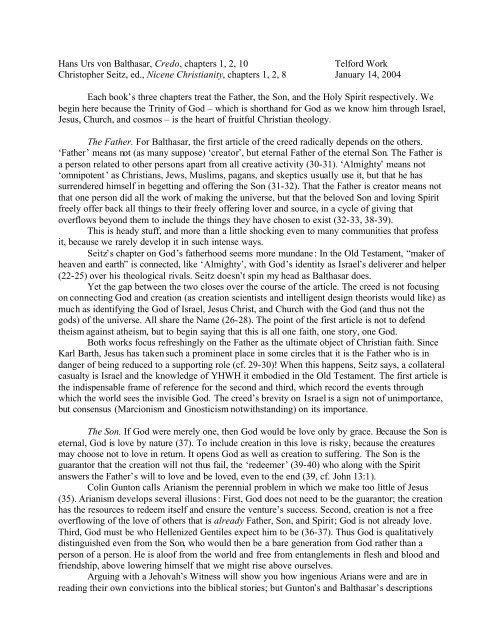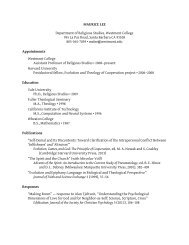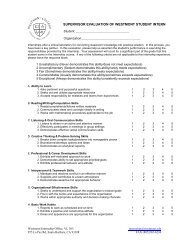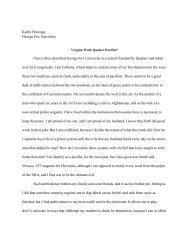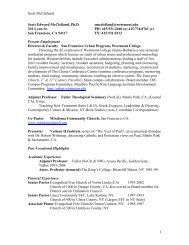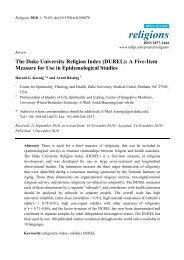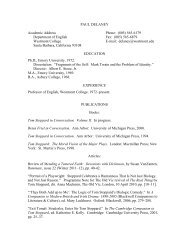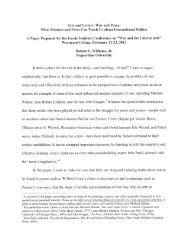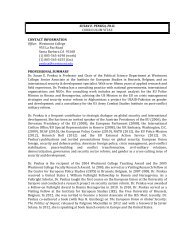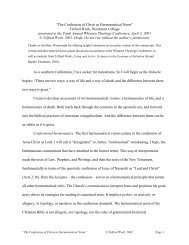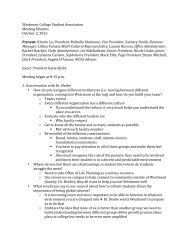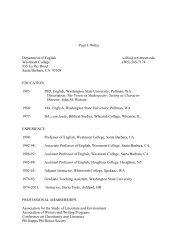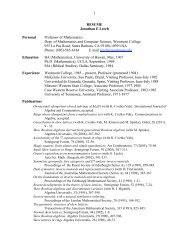Hans Urs von Balthasar, Credo, chapters 1, 2, 10 Telford Work ...
Hans Urs von Balthasar, Credo, chapters 1, 2, 10 Telford Work ...
Hans Urs von Balthasar, Credo, chapters 1, 2, 10 Telford Work ...
Create successful ePaper yourself
Turn your PDF publications into a flip-book with our unique Google optimized e-Paper software.
<strong>Hans</strong> <strong>Urs</strong> <strong>von</strong> <strong>Balthasar</strong>, <strong>Credo</strong>, <strong>chapters</strong> 1, 2, <strong>10</strong><strong>Telford</strong> <strong>Work</strong>Christopher Seitz, ed., Nicene Christianity, <strong>chapters</strong> 1, 2, 8 January 14, 2004Each book’s three <strong>chapters</strong> treat the Father, the Son, and the Holy Spirit respectively. Webegin here because the Trinity of God – which is shorthand for God as we know him through Israel,Jesus, Church, and cosmos – is the heart of fruitful Christian theology.The Father. For <strong>Balthasar</strong>, the first article of the creed radically depends on the others.‘Father’ means not (as many suppose) ‘creator’, but eternal Father of the eternal Son. The Father isa person related to other persons apart from all creative activity (30-31). ‘Almighty’ means not‘omnipotent’ as Christians, Jews, Muslims, pagans, and skeptics usually use it, but that he hassurrendered himself in begetting and offering the Son (31-32). That the Father is creator means notthat one person did all the work of making the universe, but that the beloved Son and loving Spiritfreely offer back all things to their freely offering lover and source, in a cycle of giving thatoverflows beyond them to include the things they have chosen to exist (32-33, 38-39).This is heady stuff, and more than a little shocking even to many communities that professit, because we rarely develop it in such intense ways.Seitz’s chapter on God’s fatherhood seems more mundane: In the Old Testament, “maker ofheaven and earth” is connected, like ‘Almighty’, with God’s identity as Israel’s deliverer and helper(22-25) over his theological rivals. Seitz doesn’t spin my head as <strong>Balthasar</strong> does.Yet the gap between the two closes over the course of the article. The creed is not focusingon connecting God and creation (as creation scientists and intelligent design theorists would like) asmuch as identifying the God of Israel, Jesus Christ, and Church with the God (and thus not thegods) of the universe. All share the Name (26-28). The point of the first article is not to defendtheism against atheism, but to begin saying that this is all one faith, one story, one God.Both works focus refreshingly on the Father as the ultimate object of Christian faith. SinceKarl Barth, Jesus has taken such a prominent place in some circles that it is the Father who is indanger of being reduced to a supporting role (cf. 29-30)! When this happens, Seitz says, a collateralcasualty is Israel and the knowledge of YHWH it embodied in the Old Testament. The first article isthe indispensable frame of reference for the second and third, which record the events throughwhich the world sees the invisible God. The creed’s brevity on Israel is a sign not of unimportance,but consensus (Marcionism and Gnosticism notwithstanding) on its importance.The Son. If God were merely one, then God would be love only by grace. Because the Son iseternal, God is love by nature (37). To include creation in this love is risky, because the creaturesmay choose not to love in return. It opens God as well as creation to suffering. The Son is theguarantor that the creation will not thus fail, the ‘redeemer’ (39-40) who along with the Spiritanswers the Father’s will to love and be loved, even to the end (39, cf. John 13:1).Colin Gunton calls Arianism the perennial problem in which we make too little of Jesus(35). Arianism develops several illusions: First, God does not need to be the guarantor; the creationhas the resources to redeem itself and ensure the venture’s success. Second, creation is not a freeoverflowing of the love of others that is already Father, Son, and Spirit; God is not already love.Third, God must be who Hellenized Gentiles expect him to be (36-37). Thus God is qualitativelydistinguished even from the Son, who would then be a bare generation from God rather than aperson of a person. He is aloof from the world and free from entanglements in flesh and blood andfriendship, above lowering himself that we might rise above ourselves.Arguing with a Jehovah’s Witness will show you how ingenious Arians were and are inreading their own convictions into the biblical stories; but Gunton’s and <strong>Balthasar</strong>’s descriptions
show how forced Arian storytelling becomes (39-41). This is equally true regarding the significanceof Israel. Arianism gets God’s people wrong as much as it gets God wrong.A second look at that last sentence shows why this must be so. We are right to infer from thestory of God in the world (‘the economic Trinity’) claims we make about God in himself (‘theimmanent Trinity’).This takes Gunton into a recent theological debate over whether it is healthy to distinguish atall between the two. Against the Hegelian spirit of some contemporary theology (Rahner, LaCugna,Moltmann, etc.), Gunton reasonably claims that the best way forward is harmony but not identity ofthe immanent and economic Trinity (42-47). God freely acts in the world as God really is ineternity. Distinguishing in this way preserves the force of ‘freely’ in that sentence. And this bringsus right back to <strong>Balthasar</strong>. What Arius does to protect God’s unity and transcendence both deniesthe connection between God and creation and confuses the two! Arius makes God more ‘spiritual’than God really is. We creatures are left to do the work we have forbidden God from doing. Yet thatsupposes that we have powers of our own that in fact we do not, trivializing the grace that makingand saving creatures is all about. Israel knew it was no angel or heathen god or human being withthe power to deliver the Hebrews from Egypt, as Christians knew it was no lesser deity or mere manwho now holds the keys to death and Hades. It was Jesus of Nazareth who is our Passover, theLord, our creator and redeemer (44).The Holy Spirit. Gunton ends with a carefully delineated Trinitarian account of creation andredemption, which inevitably brings into focus the person of the Holy Spirit (45-48), who is thesubject of one more section of each book. In the fourth century the Church realized that Arian andanti-Arian logic applied to the Spirit as well as the Son. Thus the Spirit has his own article of thecreed (<strong>Balthasar</strong> 75-76, Seitz 149-150).Thomas Smail describes the Spirit as personal in a different way from the others, for he isnot the object of our relationship as they are, but only enables us to relate to the others (152). He isthe life-giver (153), while the Son is the life. Q: Does this distinction come too close tosubordinating the Spirit to the Son, or are my Pentecostal sensibilities just being offended? Cf. hisswipe on 162.Both <strong>Balthasar</strong> and Smail concentrate on the ancient controversy of the Filioque, of whetherthe Spirit proceeds from the Son as well as the Father. Rhetorical Q: Does it matter?! I think theymake pretty good cases that it does.<strong>Balthasar</strong> describes Augustine’s Trinity has the Father ‘thinking’ the Son and thus the twoloving through the Spirit. But does not the thinking arise out of loving as well as the converse (77)?Neither is subordinate to the other.Smail’s Filioque material supports <strong>Balthasar</strong> brilliantly. He shows that in salvation historyneither the Spirit nor the Son is prior to the other. The Son as well as the Father sends the Spirit(John 15:26, 16:7 on 155). Christology is as much a matter of following the Spirit as the Son (seethe amazing 162-164). We should say not only that the Spirit proceeds from the Father through theSon but also that the Son is begotten of the Father through the Spirit (164). I concur!Q: How then can he maintain that distinction on pages 152-153? Doesn’t ChristocentricPentecostalism honor the his conclusion better than his own ex-charismatic Anglicanism?<strong>Balthasar</strong>’s vast stylistic differences with Seitz, Gunton and Smail make these two booksseem worlds apart, but they are actually deeply compatible and, if you take the trouble to figurethem out, as provocative as they are enormously satisfying. Stick with them, folks!


